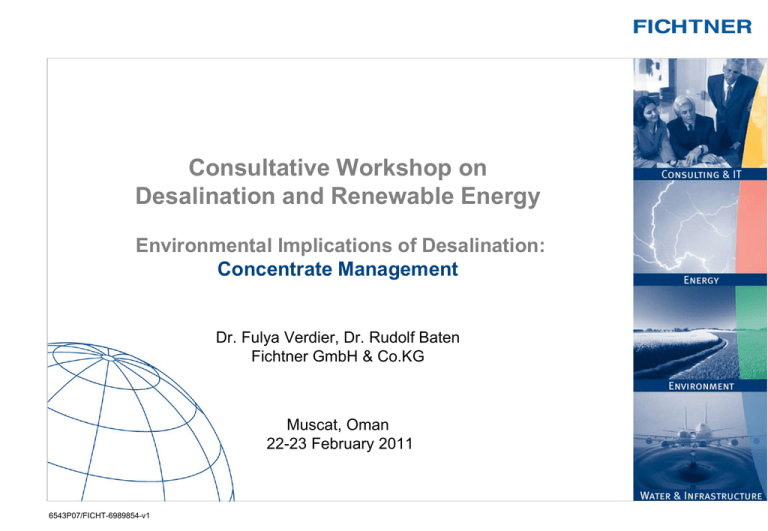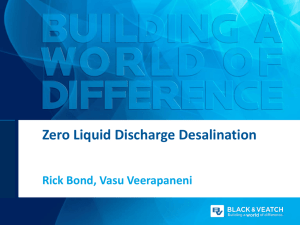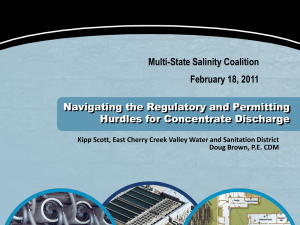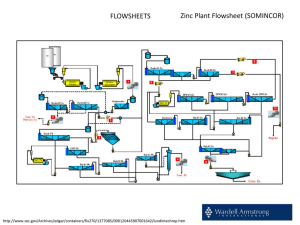Environmental Implications of Desalination: Concentrate Management
advertisement

Consultative Workshop on Desalination and Renewable Energy Environmental Implications of Desalination: Concentrate Management Dr. Fulya Verdier, Dr. Rudolf Baten Fichtner GmbH & Co.KG Muscat, Oman 22-23 February 2011 6543P07/FICHT-6989854-v1 Table of Contents Need for Concentrate Management Characteristics of Concentrate Potential Environmental Impacts Impact Mitigation Measures Concentrate Management Options Conclusions 6543P07/FICHT-6989854-v1 2 Concentrate Management There is increasing need, because of: Increasing number and size of desalination plants Increasing accumulation of desalination plants in certain regions Increasing concentrate volumes Limited available disposal options More strict environmental regulations (e.g. groundwater protection) Increasing public awareness and environmental concerns 6543P07/FICHT-6989854-v1 3 Characteristics of Concentrate Typically there are three types of desalination plant discharges: Brackish water concentrate Seawater concentrate Process effluents Salinity level of concentrate highly depends on feed water salinity and recovery Volume of concentrate is much greater than volume of process effluents 6543P07/FICHT-6989854-v1 4 Characteristics of Concentrate Overview on the relevant discharge flows Desalination Technology RO / MED / MSF RO Relevant Discharge Flow Content Seawater concentrate Salt Content & Heat Biocide (Chlorine) Chemical Anti-scalants Chemical Filter backwash waste water Suspended Solids Sodium bisulfite (SBS) Chemical Coagulants Chemical Flocculants Chemical Corrosion inhibitors Chemical Anti-foam agents Chemical MED / MSF 6543P07/FICHT-6989854-v1 5 Potential Impacts of Concentrate Physio-chemical Impacts Increased salinity, temperature and density of concentrate relative to receiving environment Contaminants Biocides (e.g. NaOCl or Cl2) Dechlorination using SBS (sodium bisulfite) Antiscalants (polymeric substances) Cleaning chemicals (acid, base, detergents) Coagulants from RO plants (e.g.FeCl3) causing reddish color Antifoaming agents from thermal plants (polyethylene, polypropylene) Traces of heavy metals if there is corrosion of plant equipment 6543P07/FICHT-6989854-v1 Cause - Impact Assessment “Cause Impact Assessment” is difficult to determine since there is no direct link the receiving eco-system is complex thorough investigations and analysis with adeaquate replication on annual basis are required to establish statistical analysis of results comparative analysis of trends Even if some cause and effect relationships are not fully established scientifically, “precautionary measures” should be considered 6543P07/FICHT-6989854-v1 7 Impact Mitigation The approaches are two-fold: Environmental Impact Mitigation of Concentrate Process Effluent Treatment Concentrate Management Options: Concentrate Disposal & Volume Reduction 6543P07/FICHT-6989854-v1 8 Impact Mitigation Measures Waste water treatment plant (WWTP) including sludge treatment 6543P07/FICHT-6989854-v1 9 Impact Mitigation Measures Surface Water Discharge Measures to reduce the extent of impacts i.e. diffusers for enhanced mixing and dispersion of concentrate Source: Wilf (2007) 6543P07/FICHT-6989854-v1 Source: Bleninger (2007) 10 Impact Mitigation Measures “Best practice” desalination plant Minimization of plant wastes (liquid, solid) Process optimization in order to minimize the discharge flow quantity and contamination Involvement of waste water treatment plants (WWTP) including sludge treatment Neutralization of chemicals prior to discharge (~ pH=7) 6543P07/FICHT-6989854-v1 11 Further Measures Relevant Legislations and Guidelines Generally subject to national water framework MENA countries like Saudi Arabia, Oman, Israel and Egypt have introduced discharge limits for selected effluent pollutants and mixing zone regulations e.g. Omani discharge requirements limit parameters in the concentrate Temperature, Suspended solids, Total chlorine, Copper, Nickel, Molybdenum, Iron Besides the discharge limits, a mixing zone of 300 m in diameter around the outfall is specified. Within the mixing zone, no marine life at the seabed may be destroyed. Beyond the mixing zone • the ambient water temperature must not be increased by more than 1 °C (weekly average) • the average ambient salinity must not be changed by more than 2 g/l • the average dissolved oxygen level should not be reduced by more than 10% 6543P07/FICHT-6989854-v1 12 Further Measures Appropriate Site Selection Data collection and evaluation including installed desalination plants in the vicinity of plant Semi-closed areas such as Red Sea and Arabian Gulf can be more susceptiple to cumulative impacts due to limited flushing Impact modeling and assessment (EIA) prior to environmental permit Measures for Permit Granting Evaluation on case-by-case basis Establishment of discharge quality standards Definition of minimum requirements for outfall structure Prohibition of discharge at coast Appropriate Monitoring Before-After/ Control-Impact Monitoring 6543P07/FICHT-6989854-v1 13 Further Measures Additional (international) environmental requirements Equator Principles World Bank Standards Measures for Institutional Water Authorities Preparation of master plans for water bodies Integrated, multi-scale water resources planning Development of local, regional, national water regulations Conducting studies to promote national water program Assessment of desalination guidelines Establishment of incentives, task forces 6543P07/FICHT-6989854-v1 14 Concentrate Management Options There is no universal concentrate disposal solution for all plants and sites Surface water discharge (oceans, seas, rivers) is the most economic and common option for large concentrate volumes Sewer disposal may require fees and permit by local sewage agency Deep well injection requires highly permeable, unusable saline aquifer nearby. Its feasibility depends on hydro-geological conditions Evaporation pond is land intensive and thus rather applicable for smaller volumes Zero liquid discharge means no liquid discharge across plant boundary. It is more applied by industry by using thermal evaporators and processing to solids Selective salt recovery needs market development in the long term 6543P07/FICHT-6989854-v1 15 Concentrate Management Options & Costs Options & Benchmark Indicative Costs (1) Critical factors [US$/m³] Concentrate disposal options Surface Water 0.03 - 0.30 Piping, pumping and outfall construction Sewer 0.30 - 0.66 Disposal rate, salinity, sewer capacities, fees Deep Well Injection 0.33 - 2.64 Tubing diameter and depth, injection rate, chemical costs Evaporation Pond 1.18 - 10.04 Pond size and depth, salt concentration, evaporation rate, disposal rate, pond liner cost Zero Liquid Discharge 0.66 - 26.41 Disposal rate, energy costs, salinity Benchmark Membrane replacement Chemicals (1) Costs 0.008 - 0.05 0.008 - 0.05 include CAPEX and OPEX costs after Greenlee et al., 2009 6543P07/FICHT-6989854-v1 16 Conclusions Pioneer installations are operated for backwash water treatment (e.g. Perth SWRO, Sydney SWRO, planned for Raz Azzour hybrid plant), the related costs are not significant Eco-toxicity and chemical dosing rates has been reduced Measures to mitigate concentrate impacts are state-of-the-art Concentrate minimization is not yet established. Currently limiting factors are related to economics rather than technical feasibility Today’s best practice is expected to become minimum requirement for future desalination plants MENA countries can provide a suitable platform to establish a common consensus 6543P07/FICHT-6989854-v1 17 Concentrate Management Thank you! 6543P07/FICHT-6989854-v1 18









